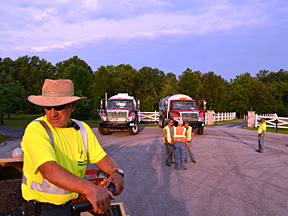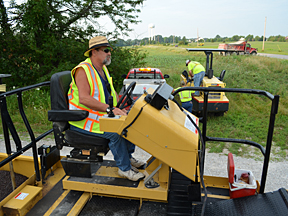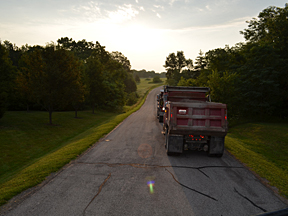Boone County News Release
For Immediate Release
Media Contact:
Boone County Commission Administrative Coordinator
Phone: (573) 886-4312
Boone County extends life of county roads with seal coat
July 19, 2011
It was slightly cool and overcast as the Boone County Public Works crew gathered at 6:30 in the morning at the staging area near Summers Lane.
"You should have come out here at 2 in the afternoon," said Roland Wren, laughing. The previous day, he said, had been a scorcher. Even protected with his broad-brimmed hat, Wren's face was deeply tanned, evidence of his work out on the roads of Boone County, work that has stretched back 34 years to when he first joined the County in 1977.
"It was all just road graders and gravel when I first started," Wren said as he worked prepping the big gravel-spreading vehicle the County uses for its resurfacing projects. This morning's work involved laying down a seal coat on Summers Lane, a short road ending in a cul-de-sac off Olivet Road.
The seal coat process — sometimes referred to as "chip-seal," although that technically refers to a different procedure — involves laying down a coat of emulsified asphalt oil quickly followed by a layer of finely chipped gravel. Boone County uses different rock for different applications. Sometimes, crushed river rock is used, distinguished by its light-brown appearance, and often selected for its relatively low cost.
The Summers Lane resurfacing, however, would use Iron Mountain trap rock, according to Greg Edington, Fleet Maintenance Supervisor with Boone County Public Works. "It has a high iron content," Edington said. "It's harder than pretty much anything you can get from around here." The hardness of the stone helps create better friction on the road surface, allowing the tires of vehicles travelling the often-winding county roads to better adhere to the road surface. The downside of using the Iron Mountain rock, though, is the expense of hauling it from the quarries that produce it in southeast Missouri.
It's the oil that goes down on the road, though, that helps extend the life of the road, according to Boone County civil engineer Dan Haid. "A lot of the protection for the road comes from the oil that's put down anyway," Haid said. "The rock is just the wearing surface."
Haid said that the oil is especially designed for the chip-seal process, and that it helps seal the road's asphalt. "A seal coat is a preventative maintenance practice. It's applied to roads in good condition to protect them and extend their lives," Haid said. "How it works is that, after a road receives an overlay of asphalt, approximately 3 years later, it will get a seal coat on it. What that does is seal off the asphalt from weathering and oxidation. It allows the chip seal to be the wearing course, so that any surface defect that happens happens in that instead of in the asphalt."
A road typically gets another seal coat treatment 7 years later, Haid said. After that, the road will probably have degraded to the point that a chip seal treatment will no longer be effective, and the road will need to receive another asphalt overlay.
Of course, the individual circumstances of a road's condition determines what course of action the County takes in maintaining it. "We have roads that are built on different cross sections, different terrains," Haid said. "A lot of factors go into it. We differentiate between higher traffic roads and local roads that have different life cycles."
Out on Summers Lane, the crew began maneuvering their vehicles into place on the cul-de-sac to lay down the seal coat. Putting down a seal coat requires a fairly large crew — 16 workers, plus the drivers of the dump trucks hauling the stone from Public Works' storage facility.
First, sweepers cleaned the road surface of any debris so that the chip seal can adhere to the road. Next, tanker trucks filled with oil sprayed the road surface. Articulated arms fitted with a row of nozzles extended from the back of the truck, and the driver carefully maneuvered his vehicle, ensuring that no oil was sprayed off the road surface.
The gravel spreader moved in next. The vehicle is so big that it takes two workers to operate it properly. Wren occupied the right front workstation where he could operate the spreader's retractable arms, while Bobby Craig sat in the driver's seat.
Like Wren, Craig is a long-time Boone County employee — 19 years this August. He also remembered how road work changed over his years with the County.
The spreader the County used when he first started with the County, Craig remembered, was a device that attached to the back of a dump truck. "That was dangerous," Craig said. "You had to get your arms in between the spreader and the truck to get it attached." It was an improvement a few years later when the County got its first spreader vehicle — similar to what it uses currently, but smaller. "I was the first operator," Craig said.
Craig drove the spreader out onto the freshly oiled cul-de-sac. The driver's seat slid across the deck of the machine, allowing Craig to visually line up the spreader properly. Theoretically, one worker could operate the spreader by himself, but it's easier with two. Once positioned, Craig moved the spreader, and rock chips began to rain down onto the oil. The hopper in the rear of the spreader feed stone onto conveyor belts that delivered it into the retractable arms. Gates on the arms opened based on where the stone was needed, Wren working the operations on the right side while Craig operated on the left, in addition to driving.
In little more than a minute, the huge hopper was empty. With only a few words on the radio, Craig summoned a dump truck to fill the hopper again. The process continued several times — oil truck laying down oil on the cul-de-sac, spreader laying down chipped rock. Once the rock was down, it was rolled into the oil with two rubber-tired rollers — articulated vehicles each with two rows of five truck tires, both weighed down with a container full of gravel or a huge water tank. This was followed by the sweepers, which removed any loose rock.
The work went quickly, the crew maneuvering their large, cumbersome vehicles with unexpected grace and efficiency in the narrow laneway. Once the circle of the cul-de-sac was finished, work on the straight road could begin. As fast as the work had been on the cul-de-sac, work on the road itself went faster. Both oil trucks were able to lay down a coat of liquid asphalt, quickly followed by the spreader, extending its arms out to the full 22-feet width of the road. So much gravel was going through the system at this point that the spreader required the dump trucks to just hook up behind the spreader's hopper, and let the big vehicle drag them backward while they dumped their loads into the machine.
"We can do about four, five miles a day," Craig said as Wren guided a new dump truck behind the spreader. Each dump truck carried 12 to 13 tons of rock, but the spreader emptied them out in no more than five minutes.
This year, Boone County resurfaced about 17.5 miles, comparable to the work done in 2010. "Next year I'm planning on doing about twice as much as that," Haid said. "Just because it's just that point in the life of our complete system that there's just more of these that happen to need to be done next year."
Traffic along Olivet waited patiently as the spreader and the other vehicles maneuvered where Summers Lane went into it, putting the finishing touches on this road's resurfacing. In less than two hours, the crew had managed to complete the chip-seal process on this stretch of road. They quickly move out of the way, allowing the traffic to pass, and began the process of loading up and preparing their equipment to move on to the next stretch of road requiring their attention. It was still early in the day; there was a lot more work to do.
###



